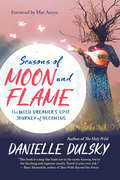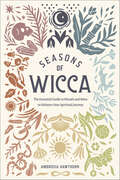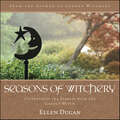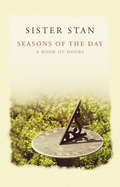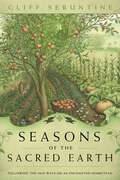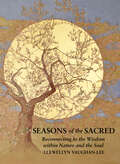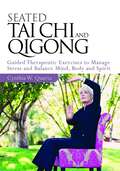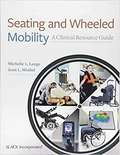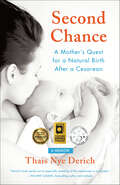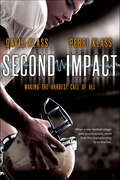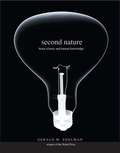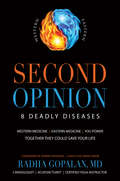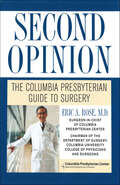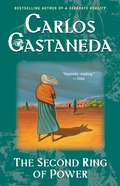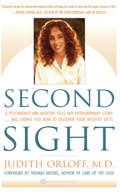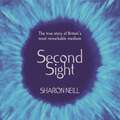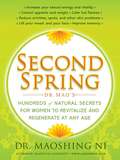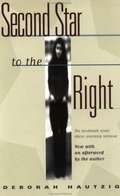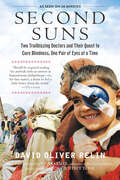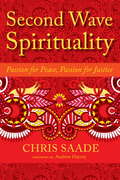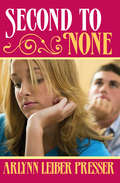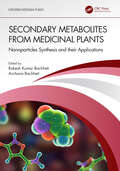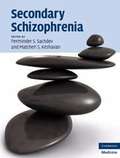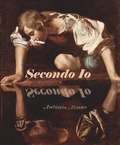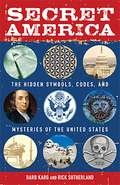- Table View
- List View
Seasons of Moon and Flame: The Wild Dreamer’s Epic Journey of Becoming
by Danielle DulskyPrepare to Be Mentored by the Sacred Hags! The yearning to slow down and simplify, return to the earth, and maybe even &“rewild&” what has been tamed in ourselves persists even though that dream may seem ever more remote in contemporary life. Danielle Dulsky shows that even in our high-tech and high-pressure lives, it is possible to manifest your own &“year of the wild&” and to tap into often-forgotten holy wisdom. Seasons of Moon and Flame guides you to live cyclically while working with the archetype of the Sacred Hag, or wild grandmother, who appears in various guises. Wonderfully inclusive, with adaptations for families, spiritual groups, and other traditions, this book is a potentially life-changing guide to living mystically, magically, and in empowering harmony with the worlds of spirit and nature.
Seasons of Wicca: The Essential Guide to Rituals and Rites to Enhance Your Spiritual Journey
by Ambrosia HawthornStrengthen your practice, deepen your faith—Wiccan rites and rituals for every seasonRooted in nature, spiritualism, and a reverence for the divine, Wicca is a religious practice focused on the balance and harmony between life and nature. Seasons of Wicca offers practical guidance and empowering rites and rituals that will bring the magic of Wicca into your daily life.Discover the origins of Wicca with an overview covering the importance of working with nature and the deities. Explore in-depth primers on the Wheel of the Year and the crucial purposes of the elements, and embark on your own spiritual path with step-by-steps for Sun Celebrations, Moon Celebrations, and Wiccan Rites.Seasons of Wicca includes:Start of the season—Begin your practice with practical advice on setting up an altar and casting a circle, as well as the tools for magical transformation, like tarot, runes, candles, and crystals.Modern Wicca—Choose the Wicca tradition that's best for you with a look at the practices and deities of popular traditions, such as Gardnerian, Celtic, and Solitary Wicca.Seasonal ceremonies—Find easy-to-follow rituals for Wiccan sabbats and full moon esbats, as well as rites for major changes, like handfasting, a Wiccan wedding ceremony, and handparting to mark the end of a relationship.Celebrate the changing of the seasons, sabbats, and deities with the life-changing rites and rituals in Seasons of Wicca.
Seasons of Witchery: Celebrating the Sabbats with the Garden Witch
by Ellen DuganIn this charming book, award-winning author Ellen Dugan offers an intimate look at her personal practices and magickal life throughout the wheel of the year. Written with humor, warmth, and practicality, Ellen offers a fresh twist on ways to honor each season, along with insightful journal notes about her enchanted gardens. Her magickal lessons and stories about her own coven—how they celebrated, changed, and grew over the course of the year—will inspire you. Enjoy sabbat-themed spells, rituals, herbal magick, and holiday recipes that will motivate you to make your own seasons of witchery more unique and meaningful.Midsummer Faery Garden BlessingButterfly MagickJack-o'-Lantern SpellThe Wild Hunt at YuletideAn Imbolc Spell to Celebrate the Goddess BrigidPerfect Eggs for OstaraHerbal Bouquets and Tussie-Mussies
Seasons of the Day
by Stanislaus KennedyBased on the traditional Book of Hours - psalms said daily, at set times, by religious communities throughout the world - Seasons of the Day reveals the enduring relevance of this ancient practice to contemporary living.In Seasons of the Day, Sister Stan, knowing that our modern-day understanding of time pushes us to our stressed-out limits, passes on the monastic ritual to the layperson.Here, as she slows us down, she reveals the psalms through her own words, her own prayers. Using them, she also guides us tenderly through a four-week period, from the silence and mystery of pre-dawn (matins) through to the reflective conclusion of the day (compline). In a world that can often seem hostile and unfriendly, her gentle reflections help the reader find inner peace and confidence.A prayer book for today
Seasons of the Sacred Earth: Following the Old Ways on an Enchanted Homestead
by Cliff Seruntine"We are just one little family on a small homestead deep in a wild place. What we can do is small, but perhaps through this book we can impart the wisdom we have discovered. It is just this: spirit and enchantment and reality are bound together in a green world full of wonders."Living Green with the Spirits of the LandIn 2007, the Seruntine family relocated to a secluded Nova Scotia homestead. They made it a point to live gently upon the land by growing and raising their own food, living in balance with the surrounding forest, and honoring Nature's spirits. In return, the land and the spirits looked after them. Seasons of the Sacred Earth follows life deep in their woodland hollow through a magical year. It is a marvelous journey into a place where gardens grow by love and magic, where children romp through enchanted forests, where mystery beckons by light of fireflies. And living close to Nature, they discover an ancient truth: the magical and the mystical are never farther than Earth and Sky.
Seasons of the Sacred: Reconnecting to the Wisdom within Nature and the Soul
by Llewellyn Vaughan-LeeIn this timely third book in his "Spiritual Ecology" series, Llewellyn Vaughan-Lee continues his exploration of the many facets of interconnection between humanity and the Earth. Deeply spiritual but not religious, "Seasons of the Sacred" weaves together narratives, poems, and images from various sources to illuminate the hope, beauty, abundance, and darkness of the Earth's cycles and humanity's place therein.Likening Spring to falling in love, Summer with abundance and spiritual awakening, Fall with fruition and wisdom, and Winter with contraction and emptiness, the collected wisdom reflects the profound resonance of humanity within nature and emphasizes the deep alignment between the Earth and human soul. Ultimately, Vaughan-Lee tells a story of connection and synchronization, illustrating how humanity and the Earth are journeying together in both obvious and mysterious ways, mutually sharing, adapting, and learning. While Vaughan-Lee is a Sufi teacher, the book offers nature-based wisdom from Christianity, Buddhism, Judaism, and literary traditions from across the ages.Vaughan-Lee adeptly connects the reader to the deepest envisioning of contemporary challenges. Climate catastrophe, refugees, cultural degradation, and political divisiveness are all contextualized within natural cycles of birth, loss, and transition, and the reader is guided to listen through the fear and anxiety of our age to the deeper ground of belonging that calls from even the most destitute inner and outer landscapes.Never more relevant than now, the chapter on Winter points the reader to what is most essential even as the temporal is stripped away like autumn leaves, providing some assurance that there is meaning and even peace amidst the devastation of our present time. As with other books in this series, Vaughan-Lee places the human story within the story of the Earth and compels the examination of attitudes, beliefs, and habits in relation to the ongoing desecration, ecological devastation—and potential restoration—of our sacred home.
Seated Taiji and Qigong: Guided Therapeutic Exercises to Manage Stress and Balance Mind, Body and Spirit
by Michelle Maloney Vallie Cynthia W. QuartaPractising Taiji and Qigong is the perfect antidote to the stresses of modern life and a great way to stay healthy. Now caring professionals can help those with limited mobility to experience the benefits of Taiji and Qigong with this easy-to-follow guide. Covering everything caregivers need to know about Taiji and Qigong, this illustrated guide provides an explanatory introduction to these forms of exercises and shows how to build up a program from easy steps to more challenging ones. There are exercises to stimulate every part of the body, with variations to suit the patient's needs and preferences. All the movements are adapted from the same ancient principles guiding classic Taiji and Qigong and will help strengthen the body as well as provide contemplative relaxation. This book will show occupational therapists, physical therapists, nurses, activity directors, mental health practitioners, martial arts instructors, and anyone else working with people with physical disabilities and the elderly exactly how these simple techniques can make big improvements to a person's physical and mental wellbeing.
Seating And Wheeled Mobility: A Clinical Resource Guide
by Michelle L. Lange Jean MinkelSeating and Wheeled Mobility: A Clinical Resource Guide presents clinical assessment considerations when working with a person with a disability who may need wheelchair seating for postural support, skin integrity, or a wheelchair base to best meet dependent or independent mobility needs. <p><p> Michelle L. Lange and Jean Minkel have designed this text to support occupational and physical therapists, complex rehabilitation technology suppliers, and even third-party payers who are interested in wheelchair seating and mobility assessment and applications. Seating and Wheeled Mobility provides a wide spectrum of information from foundational information for those practitioners who are new to the field to in-depth, population-specific information for practitioners who perhaps have not worked with a particular population in the past. <p> Seating and Wheeled Mobility: A Clinical Resource Guide provides the depth and breadth of the clinical practice of wheelchair seating and mobility to both those who are new to the field, as well as seasoned professionals.
Second Chance: A Mother's Quest for a Natural Birth After a Cesarean
by Thais Nye DerichOn the joyful day of her son’s birth, Thais Derich never questioned going to the hospital. A week later, she walked out physically, spiritually, and emotionally injured, and fully disabused of the idea that the medical field would ever put her best interests before protocol, money, and legal concerns. The next three years of her life were spent recovering from that day, and preparing herself to do things her way when she became pregnant again. And then she did get pregnant again—and that resolve was put to the test. A universal story about betrayal and trust and the roller coaster ride in between, Second Chance illuminates the many ways in which our healthcare system is broken when it comes to helping women give birth, and gives a voice to all the mothers who have walked away from their delivery experiences wondering what the hell just happened.
Second Impact: Making the Hardest Call of All
by David Klass Perri KlassKendall is football town, and Jerry Downing is the high school's star quarterback, working to redeem himself after he nearly killed a girl in a drunk driving accident last year. Carla Jenson, lead reporter for the school newspaper's sports section, has recruited Jerry to co-author a blog chronicling the season from each of their perspectives. When Jerry's best friend on the team takes a hit too hard and gets hurt, Carla wonders publicly if injury in the game comes at too high a cost in a player's life—but not everyone in Kendall wants to hear it...David Klass and Perri Klass's Second Impact is an action-packed story will resonate with readers who have been following recent news stories are football injuries.
Second Nature: Brain Science and Human Knowledge
by Gerald M. EdelmanBurgeoning advancements in brain science are opening up new perspectives on how we acquire knowledge. Indeed, it is now possible to explore consciousness-the very center of human concern-by scientific means. In this illuminating book, Dr. Gerald M. Edelman offers a new theory of knowledge based on striking scientific findings about how the brain works. And he addresses the related compelling question: Does the latest research imply that all knowledge can be reduced to scientific description? Edelman's brain-based approach to knowledge has rich implications for our understanding of creativity, of the normal and abnormal functioning of the brain, and of the connections among the different ways we have of knowing. While the gulf between science and the humanities and their respective views of the world has seemed enormous in the past, the author shows that their differences can be dissolved by considering their origins in brain functions. He foresees a day when brain-based devices will be conscious, and he reflects on this and other fascinating ideas about how we come to know the world and ourselves.
Second Opinion
by Radha GopalanMost people would agree that we aren't taught much about 'wellness.' And while there seems to be an increased awareness related to 'fitness,' more often than not we only think about 'health' or doctors when we're sick. What's left in the middle of those two extremes is a life-long struggle to stay healthy and productive in a world of mixed medical messages.For the first time, Dr. Radha Gopalan, gifted heart transplant Cardiologist, Acupuncturist and Yoga Teacher, clears up the confusion around health, wellness, and illness. And he does it in a way that will change the way you think about yourself-and medicine-forever.Dr. Gopalan merges his education and experience in both Eastern and Western medicine to look at health and wellness from a unique and powerful perspective and delivers not only concepts and philosophies that can change the way you think about health and wellness, but assesses the most common medical conditions that impact our world-from cancer and diabetes to heart disease, obesity, and chronic illnesses.In Second Opinion, Dr. Gopalan will explain: how Eastern and Western medicine can work together for optimum health and wellness ? how you can influence the outcome of your health-and disease ? how the five levels of the H-I Triangle shape your personality, reactions, health, and ?happiness ? how insurance and finances are affecting your healthcare ? why some people who eat healthy, exercise, and lead a healthy lifestyle still have a heart ?attack ? how being healthy has more to do with who you must be than what you must do ?
Second Opinion: The Columbia Presbyterian Guide to Surgery
by Eric A. RoseSecond Opinion is the definitive resource for any of the 15 million people each year who are told they need surgery. This is the one book to turn to when you are sorting out whether or not to have surgery. Dr. Eric Rose and his collegues provide patients a reassuring arsenal of approaches and alternatives so they can participate fully in this important process to assure the best possible outcome. You'll want to bring Second Opinion with you for note-taking, list making, references, and support. It will help you be your own best advocate.Other features include:*45 of the most common operations described in detail*Full illustrations*Reasons to have the operation*What can happen if you don't*Possible complications*What to expect after surgery*Extensive, unbiased resources for getting a second opinion*Patient's worksheets, notes, and rights
Second Ring of Power
by Carlos CastanedaCarlos Castaneda's extraordinary journey into the world of sorcery...he takes the reader into a sorceric experience so intense, so terrifying, and so profoundly disturbing that it can only be described as a brilliant assault on every preconceived notion of life that is don Juan's remarkable legacy to his apprentice.
Second Sight: An Intuitive Psychiatrist Tells Her Extraordinary Story And Shows You How To Tap Your Own Inner Wisdom
by Judith OrloffIn this compelling self-portrait, psychic and psychiatrist Dr. Judith Orloff draws on her own experience and that of her patients to explore the mysterious and poorly understood realm of the psychic. In riveting detail, she describes how an ignored premonition of a patient's suicide attempt convinced her to embrace her gift and incorporate it into her medical practice -- and how using psychic abilities can provide powerful healing. More than simply one woman's journey, this book will also outline effective ways to cultivate natural psychic abilities, including how to -- recognize psychic experiences in everyday life -- increase clairvoyance -- practice psychic exercises -- discover psychic empathy -- tune into messages the body is sending -- record and interpret dreams -- and more.
Second Sight: The True Story of Britain's Most Remarkable Medium
by Sharon Neill"She said I was a psychic, that she dabbled herself and recognised my talent. I thought she was barmy, didn't think anything more of it - until the night Granny appeared to me..."Sharon Neill was studying at college when she first discovered she had an ability to talk to the dead. She began trying out readings on her friends for fun and soon developed her talent. She now works as a full-time medium and is highly revered within the psychic world.In this revealing autobiography Sharon gives an insight into many of the visions that have appeared to her over the years, with a glimpse of the dark and dangerous as well as the rewarding and uplifting.Read by the author.(p) 2007 Orion Publishing Group
Second Spring
by Dr Maoshing NiTHE CHINESE REFER TO A WOMAN'S MIDLIFE transition as her Second Spring. Thanks to the simple, natural techniques of traditional Chinese medicine, the second half of a woman's life is a flowering of feminine potential rather than a physical and mental decline. Now, Dr. Mao's revolutionary Second SpringTM program gives you time-tested, completely natural treatments to enhance energy, sexuality, and health -- and initiate your own new season of vitality starting at age thirty-five, through premenopause, menopause, and beyond. Dr. Mao -- Yahoo!'s favorite natural health expert and author of the bestselling Secrets of Longevity -- offers proven natural solutions such as a surgery-free face-lift, Chinese herbs that fight memory loss, traditional remedies that improve libido and sex, and foods that keep your specific body type in peak form (they're not the same for everyone!). His safe, natural practices, outlined in more than 200 tips, can eliminate the need for expensive medicines and artificial hormones. This amazing compendium of traditional wisdom is also enjoyable to read. With chapters on topics like weight, energy, brain power, beauty, and sexual health, Second Spring allows you to target your concerns right away. At the end you'll find handy, at-a-glance lists addressing women's most common ailments. Second Spring, inspired by Dr. Mao's own mother's remarkable transformation in the second half of her life, offers an integrated lifestyle program that will help you live long, live strong, and live happy in ways that you never thought possible.
Second Star to the Right
by Deborah HautzigAs 14-year-old Leslie begins to shed the weight she feels makes her imperfect, she finds it increasingly difficult to reach out for the psychological help she knows she needs. Novel about anorexia nervosa.
Second Suns: Two Trailblazing Doctors And Their Quest To Cure Blindness, One Pair Of Eyes At A Time
by David Oliver RelinNow in paperback: a #1 New York Times–bestselling author’s gripping chronicle of “two doctors . . . bringing light to those in darkness” (Time) Second Suns is the unforgettable true story of two very different doctors with a common mission: to rid the world of preventable blindness. Dr. Geoffrey Tabin was the high-achieving “bad boy” of his class at Harvard Medical School. Dr. Sanduk Ruit grew up in a remote village in the Himalayas, where cataract blindness—easily curable in modern hospitals—amounts to an epidemic. Together, they pioneered a new surgical method, by which they have restored sight to over 100,000 people—all for about $20 per operation. Master storyteller David Oliver Relin brings the doctors’ work to vivid life through poignant portraits of their patients, from old men who can once again walk treacherous mountain trails, to children who can finally see their mothers’ faces. The Himalayan Cataract Project is changing the world—one pair of eyes at a time.
Second Wave Spirituality
by Andrew Harvey Chris SaadeIn his work as a spiritual teacher interacting with seekers and activists from around the world, Chris Saade has witnessed a remarkable recent phenomenon: a new wave of spirituality that is socially and globally engaged in the pursuit of justice, earth care, and solidarity. Saade calls this movement "second wave spirituality," and in this book he maps out the cutting-edge ideas that are fueling this new wave of engaged spirituality. He challenges us to rise to our spiritual task and join the millions of all faiths who are awakening to the suffering and social struggles of all living beings. According to Saade, new wave spirituality holds a vision of the intrinsic values of love: justice, global peace, solidarity, inclusion, democratic freedom, compassion, and reconciliation. Saade explores current trends of thought that are shaking the foundations of our belief systems and propelling us toward an evolutionary leap. We are in the midst of a spiritual renaissance, Saade asserts, a universal reawakening that will steer us away from the abysmal global dangers we are facing.The book also includes a collection of quotations as a resource for those working for peace, justice, and inclusion. By dividing the selections into theme-specific chapters, Saade helps us easily access the wisdom and companionship of other souls committed to our diversity, our oneness, and our pursuit of justice.ContentsForeword by Andrew HarveyIntroduction1. The Emergence of Second Wave Spirituality2. A Brief Historical Overview of "First Wave" Spirituality3. Crossing the Threshold4. The Flowering of the Feminine in Theological and Spiritual Thinking5. The Great Convergence of Spiritual Development and Action for Peace and Justice6. The Six Crucial Ideas that Converged and Generated the Global Awakening of Second Wave Spirituality7. Fourteen Additional Characteristics Essential to Second Wave Spirituality8. A Response to the Escalating Global Crisis: Love in Action9. Implications of Second Wave Spirituality for the Individual10. Practical Suggestions for Spiritual Activism11. Summary and A Blessing for the Reader12. Engaged Spirituality and Sacred Activism: Writings and Quotes
Second to None
by ArLynn Leiber PresserSECOND TO NONE, originally published under the byline ArLynn Presser Garnet Brown is seventeen years old, has a great mother, a boyfriend Andy, and a cute tutor Grant who is undeniably geeky but somehow still charming and attractive. Her life plan revolves around getting into a good college and getting out of the poor neighborhood she&’s lived in her whole life. The one where she&’s mostly known as the child of an illicit affair that cost her mother her job and reputation and that left Garnet seeing her father only every few years, in court, where her parents would argue about money. So, when her well-to-do father comes to call, asking her to come visit and meet the family: the wife, the older half-brother and the younger half-brother they had after he went back to his wife, there has to be a might big string attached. Like a son with cancer and a last-chance hope that Garnet can be a bone-marrow donor. Life hasn&’t ever been easy but it&’s suddenly gotten way harder and a surprising kiss from Grant turns everything on its head even more than suddenly having a father in her life. The choices are surprising, confusing and surprisingly romantic.
Secondary Metabolites from Medicinal Plants: Nanoparticles Synthesis and their Applications (Exploring Medicinal Plants)
by Rakesh Kumar Bachheti and Archana BachhetiMedicinal plant-based synthesis of nanoparticles from various extracts is easy, safe, and eco-friendly. Medicinal and herbal plants are the natural source of medicines, mainly due to the presence of secondary metabolites, and have been used as medicine since ancient times. Secondary Metabolites from Medicinal Plants: Nanoparticles Synthesis and their Applications provides an overview on medicinal plant-based secondary metabolites and their use in the synthesis of different types of nanoparticles. It explores trends in growth, characterization, properties, and applications of nanoparticles from secondary metabolites including terpenoids, alkaloids, flavonoids, and phenolic compounds. It also explains the opportunities and future challenges of secondary metabolites in nanoparticle synthesis. Nanotechnology is a burgeoning research field, and due to its widespread application in almost every branch of science and technology, it creates many new opportunities. As part of the Exploring Medicinal Plants series, this book will be of huge benefit to plant scientists and researchers as well as graduates, postgraduates, researchers, and consultants working in the field of nanoparticles.
Secondary Schizophrenia
by Perminder S. Sachdev Matcheri S. KeshavanSchizophrenia may not be a single disease, but the result of a diverse set of related conditions. Modern neuroscience is beginning to reveal some of the genetic and environmental underpinnings of schizophrenia; however, an approach less well travelled is to examine the medical disorders that produce symptoms resembling schizophrenia. This book is the first major attempt to bring together the diseases that produce what has been termed 'secondary schizophrenia'. International experts from diverse backgrounds ask the questions: does this medical disorder, or drug, or condition cause psychosis? If yes, does it resemble schizophrenia? What mechanisms form the basis of this relationship? What implications does this understanding have for aetiology and treatment? The answers are a feast for clinicians and researchers of psychosis and schizophrenia. They mark the next step in trying to meet the most important challenge to modern neuroscience - understanding and conquering this most mysterious of human diseases.
Secondo IO
by Antonio AlmasCiò che a volte nascondiamo di noi stessi è il riflesso di ciò che non vogliamo vedere allo specchio. Dobbiamo percepirci e accettarci o non saremo capaci di proseguire. Questo racconto è un'introspezione verso la parte narcisista che abita in noi. È un viaggio verso l'ego che non deve sopraffarci, ma bensì renderci fiduciosi verso il fatto che siamo capaci. Guardare il nostro riflesso nell'acqua non deve solo servire ad ammirarci, ma soprattutto è utile per conversare con noi stessi.
Secret America: The Hidden Symbols, Codes and Mysteries of the United States
by Barb Karg Rick SutherlandThe Washington Monument.The pyramid on the $1 bill.The Skull and Bones Society at Yale University.Common American icons-or secret symbols? From our founding fathers to our most prestigious institutions, this is a nation built on such secret symbols, rites, and rituals. So forget the textbook version of history-and embark on a fascinating and fantastic journey of America's hidden past.This tell-all handbook is your personal guide to the secret-laden people, places, and things of our great nation, including:Sign-filled national treasures in museums from coast to coastAncient mysteries of our most familiar cities, landmarks, and parksHotbeds of current Masonic, Kabbalistic, and Rosicrucian activityFreemason-planned architecture of Boston, New York, Philadelphia, and Washington, D.C.Covert clubs, societies, and associations of the ultra-rich and powerful From the U.S. Capitol in Washington, D.C., to the Institute of Noetic Sciences in Petaluma, California, this book is all you need to discover the true nature of the oldest republic on Earth-past, present, and future!
